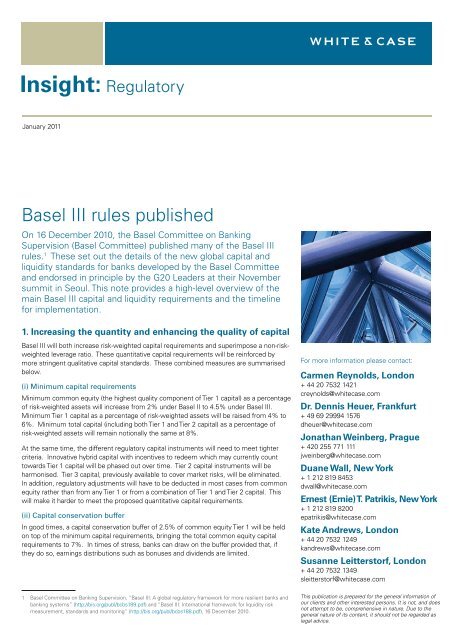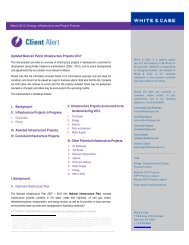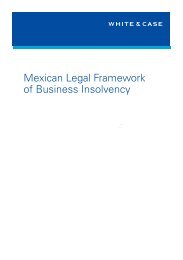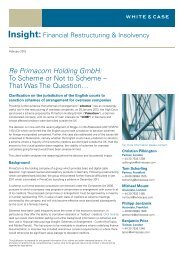Basel III rules published - White & Case
Basel III rules published - White & Case
Basel III rules published - White & Case
Create successful ePaper yourself
Turn your PDF publications into a flip-book with our unique Google optimized e-Paper software.
Insight: Regulatory<br />
January 2011<br />
<strong>Basel</strong> <strong>III</strong> <strong>rules</strong> <strong>published</strong><br />
On 16 December 2010, the <strong>Basel</strong> Committee on Banking<br />
Supervision (<strong>Basel</strong> Committee) <strong>published</strong> many of the <strong>Basel</strong> <strong>III</strong><br />
<strong>rules</strong>. 1 These set out the details of the new global capital and<br />
liquidity standards for banks developed by the <strong>Basel</strong> Committee<br />
and endorsed in principle by the G20 Leaders at their November<br />
summit in Seoul. This note provides a high-level overview of the<br />
main <strong>Basel</strong> <strong>III</strong> capital and liquidity requirements and the timeline<br />
for implementation.<br />
1. Increasing the quantity and enhancing the quality of capital<br />
<strong>Basel</strong> <strong>III</strong> will both increase risk-weighted capital requirements and superimpose a non-riskweighted<br />
leverage ratio. These quantitative capital requirements will be reinforced by<br />
more stringent qualitative capital standards. These combined measures are summarised<br />
below.<br />
(i) Minimum capital requirements<br />
Minimum common equity (the highest quality component of Tier 1 capital) as a percentage<br />
of risk-weighted assets will increase from 2% under <strong>Basel</strong> II to 4.5% under <strong>Basel</strong> <strong>III</strong>.<br />
Minimum Tier 1 capital as a percentage of risk-weighted assets will be raised from 4% to<br />
6%. Minimum total capital (including both Tier 1 and Tier 2 capital) as a percentage of<br />
risk-weighted assets will remain notionally the same at 8%.<br />
At the same time, the different regulatory capital instruments will need to meet tighter<br />
criteria. Innovative hybrid capital with incentives to redeem which may currently count<br />
towards Tier 1 capital will be phased out over time. Tier 2 capital instruments will be<br />
harmonised. Tier 3 capital, previously available to cover market risks, will be eliminated.<br />
In addition, regulatory adjustments will have to be deducted in most cases from common<br />
equity rather than from any Tier 1 or from a combination of Tier 1 and Tier 2 capital. This<br />
will make it harder to meet the proposed quantitative capital requirements.<br />
(ii) Capital conservation buffer<br />
In good times, a capital conservation buffer of 2.5% of common equity Tier 1 will be held<br />
on top of the minimum capital requirements, bringing the total common equity capital<br />
requirements to 7%. In times of stress, banks can draw on the buffer provided that, if<br />
they do so, earnings distributions such as bonuses and dividends are limited.<br />
1 <strong>Basel</strong> Committee on Banking Supervision, “<strong>Basel</strong> <strong>III</strong>: A global regulatory framework for more resilient banks and<br />
banking systems” (http://bis.org/publ/bcbs189.pdf) and “<strong>Basel</strong> <strong>III</strong>: International framework for liquidity risk<br />
measurement, standards and monitoring” (http://bis.org/publ/bcbs188.pdf), 16 December 2010.<br />
For more information please contact:<br />
Carmen Reynolds, London<br />
+ 44 20 7532 1421<br />
creynolds@whitecase.com<br />
Dr. Dennis Heuer, Frankfurt<br />
+ 49 69 29994 1576<br />
dheuer@whitecase.com<br />
Jonathan Weinberg, Prague<br />
+ 420 255 771 111<br />
jweinberg@whitecase.com<br />
Duane Wall, New York<br />
+ 1 212 819 8453<br />
dwall@whitecase.com<br />
Ernest (Ernie) T. Patrikis, New York<br />
+ 1 212 819 8200<br />
epatrikis@whitecase.com<br />
Kate Andrews, London<br />
+ 44 20 7532 1249<br />
kandrews@whitecase.com<br />
Susanne Leitterstorf, London<br />
+ 44 20 7532 1349<br />
sleitterstorf@whitecase.com<br />
This publication is prepared for the general information of<br />
our clients and other interested persons. It is not, and does<br />
not attempt to be, comprehensive in nature. Due to the<br />
general nature of its content, it should not be regarded as<br />
legal advice.
<strong>Basel</strong> <strong>III</strong> <strong>rules</strong> <strong>published</strong><br />
(iii) Countercyclical capital buffer<br />
This additional buffer of up to 2.5% of common equity Tier 1 or other fully loss-absorbing capital will have to be built up in periods of rapid<br />
aggregate credit growth which, in the opinion of national authorities, aggravates system-wide risk. The countercyclical capital buffer can<br />
be released during a downturn and, if in effect, would be an extension of the capital conservation buffer.<br />
(iv) Additional requirements for systemically important financial institutions<br />
Systemically important financial institutions could be subject to additional requirements reflecting the greater risks to financial stability that<br />
their failure would present. Work on this will continue in 2011 and areas under consideration may include capital surcharges and the<br />
introduction of contingent capital or “bail-in” debt.<br />
(v) Leverage ratio<br />
A non-risk-weighted minimum leverage ratio of Tier 1 capital to total exposures (including on-balance sheet and off-balance sheet items)<br />
will be introduced to address concerns about leverage in the financial system and back up the risk-based requirements outlined above,<br />
which may be affected by modelling errors. A minimum ratio of 3% will be tested.<br />
Comparison of <strong>Basel</strong> II and proposed <strong>Basel</strong> <strong>III</strong> capital requirements<br />
The table below provides an overview of the differences between the <strong>Basel</strong> II and the proposed <strong>Basel</strong> <strong>III</strong> quantitative capital<br />
requirements. As a result of the revised qualitative capital standards the real impact of the proposed changes will be greater than these<br />
quantitative requirements might otherwise suggest.<br />
2. Enhancing risk coverage<br />
The minimum common equity, Tier 1 and total capital requirements are calculated relative to risk-weighted assets. Under <strong>Basel</strong> <strong>III</strong>,<br />
risk-weighted assets will increase as a result of enhanced risk coverage in relation to capital market activities. Besides, <strong>Basel</strong> <strong>III</strong> aims to<br />
address certain concerns about the reliance on external credit ratings when determining risk-weights.<br />
Higher capital requirements for trading and securitisation activities<br />
In July 2009, the <strong>Basel</strong> Committee announced, among other things, higher capital requirements for trading and securitisation activities.<br />
The trading book reforms will, among other things, introduce new risk weights to better capture risks in trading portfolios. The<br />
securitisation reforms also include an increase in the risk-weighting of certain securitisations and resecuritisation exposures.<br />
Capital requirements for certain counterparty credit risk exposures<br />
<strong>Basel</strong> <strong>III</strong> will enhance capital requirements and risk management standards for counterparty credit risk exposures arising from derivatives,<br />
repos and securities financing activities. The aim is to reduce the risk of transmission of shocks between financial institutions whilst also<br />
creating incentives to move OTC derivative exposures to central counterparties and exchanges. The measures include, for example, the<br />
use of stressed inputs to determine capital requirements for counterparty credit default risk and a capital charge for mark-to-market losses<br />
associated with a deterioration in the credit worthiness of counterparties.<br />
External credit ratings in the <strong>Basel</strong> <strong>III</strong> framework<br />
<strong>Basel</strong> <strong>III</strong> contains measures in relation to the use of external credit ratings in the capital framework. Amongst other things, <strong>Basel</strong> <strong>III</strong> will<br />
incorporate elements of the International Organization of Securities Commissions’ (IOSCO) Code of Fundamentals for Credit Rating<br />
Agencies and require banks to carry out internal assessments of externally rated securitisation exposures.<br />
2<br />
<strong>Basel</strong> II <strong>Basel</strong> <strong>III</strong><br />
Common Equity Tier 1 Capital Total Capital Common Equity Tier 1 Capital Total Capital<br />
Minimum requirements 2.0% 4.0% 8.0% 4.5% 6.0% 8.0%<br />
Additional capital<br />
conservation buffer<br />
Not applicable 2.5%<br />
Additional countercyclical<br />
buffer range<br />
Not applicable 0%-2.5% 2<br />
Additional requirements<br />
for systemically important<br />
financial institutions<br />
Not applicable May be added to the other risk-weighted requirements<br />
Leverage ratio Not applicable May in effect add to the risk-weighted requirements<br />
2 Common equity or other fully loss-absorbing capital
3. Introducing liquidity requirements<br />
A combination of (i) a minimum liquidity coverage ratio to enhance short-term cash flow resilience and (ii) a structural minimum net stable<br />
funding ratio to encourage banks to better match the liquidity profile of their assets and liabilities are to be introduced.<br />
Liquidity coverage ratio<br />
The liquidity coverage ratio is designed to promote short term liquidity resilience and compares the stock of high quality liquid assets held<br />
by a bank to its net cash outflows during a hypothetical 30-day severe stress scenario. The liquidity coverage ratio will be set at a<br />
minimum of 100%, requiring high quality liquid assets to fully cover the net cash outflows in such a scenario. The liquidity coverage ratio<br />
needs to be maintained at all times.<br />
High quality liquid assets need to meet certain criteria. Some assets, for example cash and central bank reserves that can be drawn<br />
down in times of stress, qualify in their entirety. Certain other assets can be taken into account up to a limit and subject to a haircut.<br />
Net cash outflows equal cash outflows minus cash inflows, where cash inflows are capped at 75% of outflows, thus limiting a bank’s<br />
reliance on anticipated inflows to meet the liquidity requirements. Weightings are given to different types of inflows and outflows to<br />
reflect the speed at which they are expected to become available or to be withdrawn in the stress scenario.<br />
Net stable funding ratio<br />
The net stable funding ratio aims to promote resilience over a longer term horizon and incentivise banks to fund their activities with more<br />
stable sources of funding on an ongoing basis. The ratio compares the longer term stable funding available to a bank to the stable funding<br />
it requires over a one year period of extended stress and will be set at a minimum of 100%, meaning that available stable funding will<br />
have to fully match required stable funding. The minimum net stable funding ratio needs to be met at all times.<br />
Stable funding includes that share of certain types of equity and debt finance which is expected to be reliably available over the one year<br />
stress scenario. How much stable funding is required depends on the liquidity risk profiles of an institution’s assets and off-balance sheet<br />
exposures. Weightings are assigned to such assets and exposures to reflect the amount of the item which supervisors believe should be<br />
supported by stable funding.<br />
4. Timeline<br />
The higher capital requirements for trading and securitisation activities are expected to be implemented at the end of 2011. Other <strong>Basel</strong> <strong>III</strong><br />
measures are to be phased in gradually from 1 January 2013, as set out in the table below: 2<br />
2011 2012 2013 2014 2015 2016 2017 2018<br />
As of<br />
1 January<br />
2019<br />
Minimum common equity 2.0% 2.0% 3.5% 4.0% 4.5% 4.5% 4.5% 4.5% 4.5%<br />
Minimum Tier 1 capital 4.0% 4.0% 4.5% 5.5% 6.0% 6.0% 6.0% 6.0% 6.0%<br />
Minimum total capital 8.0% 8.0% 8.0% 8.0% 8.0% 8.0% 8.0% 8.0% 8.0%<br />
Capital conservation<br />
buffer<br />
0.625% 1.25% 1.875% 2.50%<br />
Countercyclical buffer ≤ 0.625% ≤ 1.25 ≤ 1.875 ≤ 2.50%<br />
Leverage ratio Supervisory monitoring Initially set at 3% during observation period from 1 January 2013 to The plan is to migrate to<br />
1 January 2017; any final adjustments in first half of 2017<br />
Pillar 1 treatment on<br />
1 January 2018<br />
Capital instruments that<br />
Either excluded from 1 January 2013 or, if they meet certain criteria, phased out over 10 years<br />
no longer qualify as<br />
common equity<br />
starting with 2013<br />
Capital instruments that<br />
Phased out over 10 years starting with 2013 (though existing public sector capital injections will<br />
no longer qualify as<br />
non-common equity Tier 1<br />
capital or Tier 2 capital<br />
be grandfathered until 1 January 2018)<br />
Phase in of regulatory<br />
adjustments<br />
20% 40% 60% 80% 100% 100%<br />
Liquidity coverage ratio<br />
(LCR)<br />
Observation period Minimum standard applies<br />
Net stable funding ratio<br />
(NFR)<br />
Observation period Minimum standard applies<br />
2 See also <strong>Basel</strong> Committee on Banking Supervision, “<strong>Basel</strong> <strong>III</strong>: A global regulatory framework for more<br />
resilient banks and banking systems”, Annex 4, 16 December 2010, http://bis.org/publ/bcbs189.pdf.<br />
<strong>White</strong> & <strong>Case</strong><br />
3
Concluding remarks<br />
In this publication, <strong>White</strong> & <strong>Case</strong> means the international legal practice comprising <strong>White</strong> & <strong>Case</strong> LLP, a New York State registered limited liability partnership,<br />
<strong>White</strong> & <strong>Case</strong> LLP, a limited liability partnership incorporated under English law and all other affiliated partnerships, companies and entities.<br />
LON1210046<br />
www.whitecase.com<br />
The aim of the <strong>Basel</strong> <strong>III</strong> capital and liquidity standards is to make banks more resilient. However, <strong>Basel</strong> <strong>III</strong> also imposes costs on banks,<br />
reducing the returns that they can earn on their assets and increasing their cost of capital. It is to be expected that banks will seek to<br />
pass these costs on to their customers to the extent possible.<br />
The capital structure of many financial institutions looks set to change as a result of <strong>Basel</strong> <strong>III</strong>. Some banks have already embarked on<br />
core capital raising exercises which have helped to secure their capital adequacy ratios. It seems quite possible that more will follow.<br />
Alternative or additional ways to meet the <strong>Basel</strong> <strong>III</strong> standards include retention of earnings or the reduction of risk-weighted assets<br />
through sales and/or a shift in the kinds of business undertaken by an institution.<br />
Banks face some uncertainty about how <strong>Basel</strong> <strong>III</strong> will be implemented across countries. National authorities may have some discretion as<br />
to how widely they apply the <strong>Basel</strong> <strong>III</strong> requirements and are also required to exercise judgement when determining the level of the<br />
countercyclical buffer to be held by banks in different circumstances. National authorities may impose more stringent capital and liquidity<br />
standards than prescribed by <strong>Basel</strong> <strong>III</strong>.<br />
In the European Union, <strong>Basel</strong> <strong>III</strong> will be implemented as part of a set of amendments to the Capital Requirements Directive (CRD) referred to<br />
as CRD IV (with the exception of the trading book and securitisation reforms covered already by earlier CRD amendments). The draft<br />
legislation for CRD IV is due to be <strong>published</strong> in the latter part of this year. Difficulties may emerge if particular countries delay implementation,<br />
as can happen with the adoption of international standards.<br />
Attorney advertising, prior results do not guarantee a similar outcome.
















